A Comprehensive Analysis of Edgar Allan Poe's 'The Raven' Poem
VerifiedAdded on 2023/06/07
|5
|1150
|400
Essay
AI Summary
This essay provides an in-depth analysis of Edgar Allan Poe's poem, 'The Raven.' The essay begins by introducing Poe and the poem's context, highlighting its influence and significance in literature. It then delves into the poem's setting, the speaker's psychological state, and the symbolism of the raven. The analysis examines the themes of grief, loss, and the supernatural, exploring the use of language, imagery, and poetic devices. The essay discusses the raven's role as a symbol of death and despair, the speaker's descent into madness, and the poem's exploration of the human psyche. The essay includes references to scholarly sources to support its interpretations and concludes by summarizing the poem's impact and enduring legacy in literature.
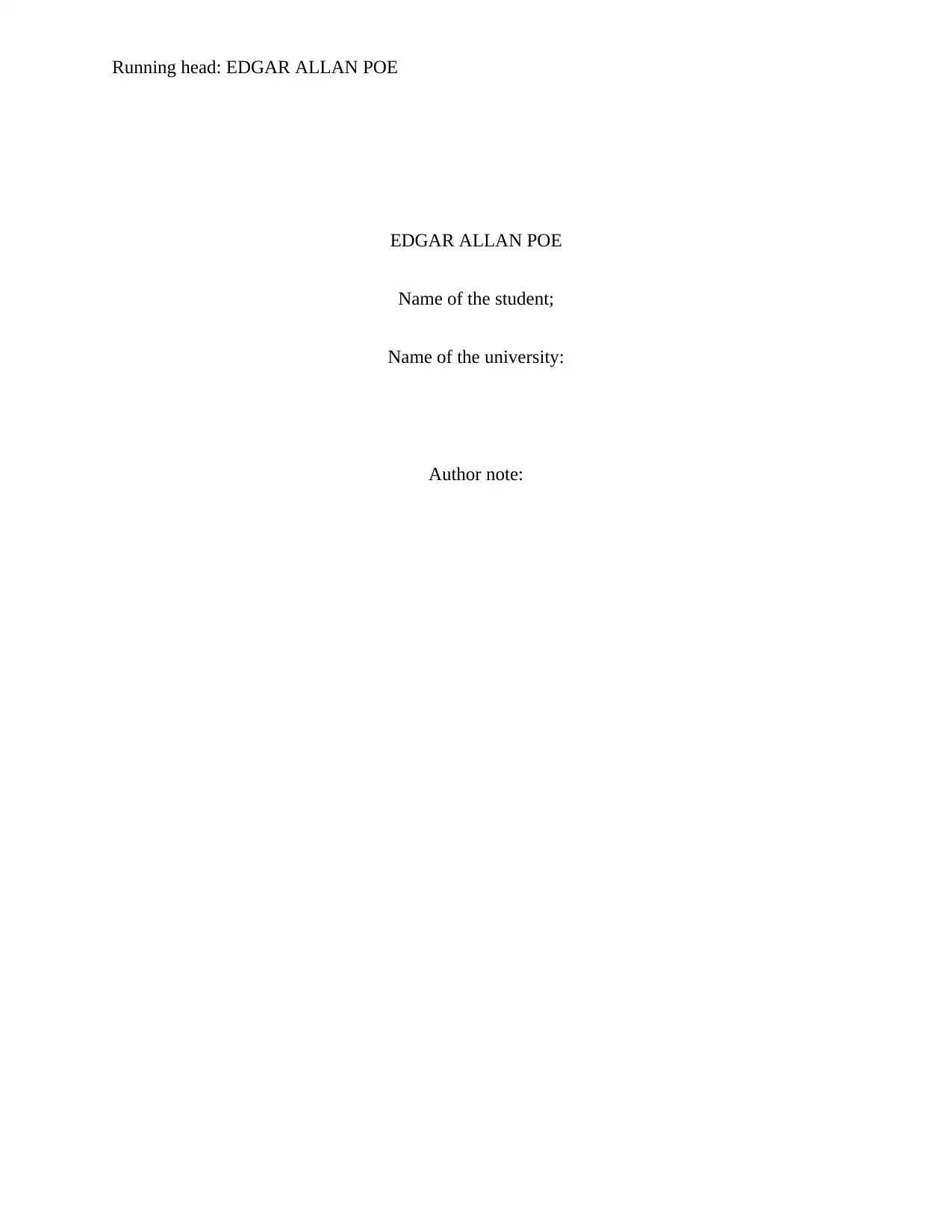
Running head: EDGAR ALLAN POE
EDGAR ALLAN POE
Name of the student;
Name of the university:
Author note:
EDGAR ALLAN POE
Name of the student;
Name of the university:
Author note:
Paraphrase This Document
Need a fresh take? Get an instant paraphrase of this document with our AI Paraphraser
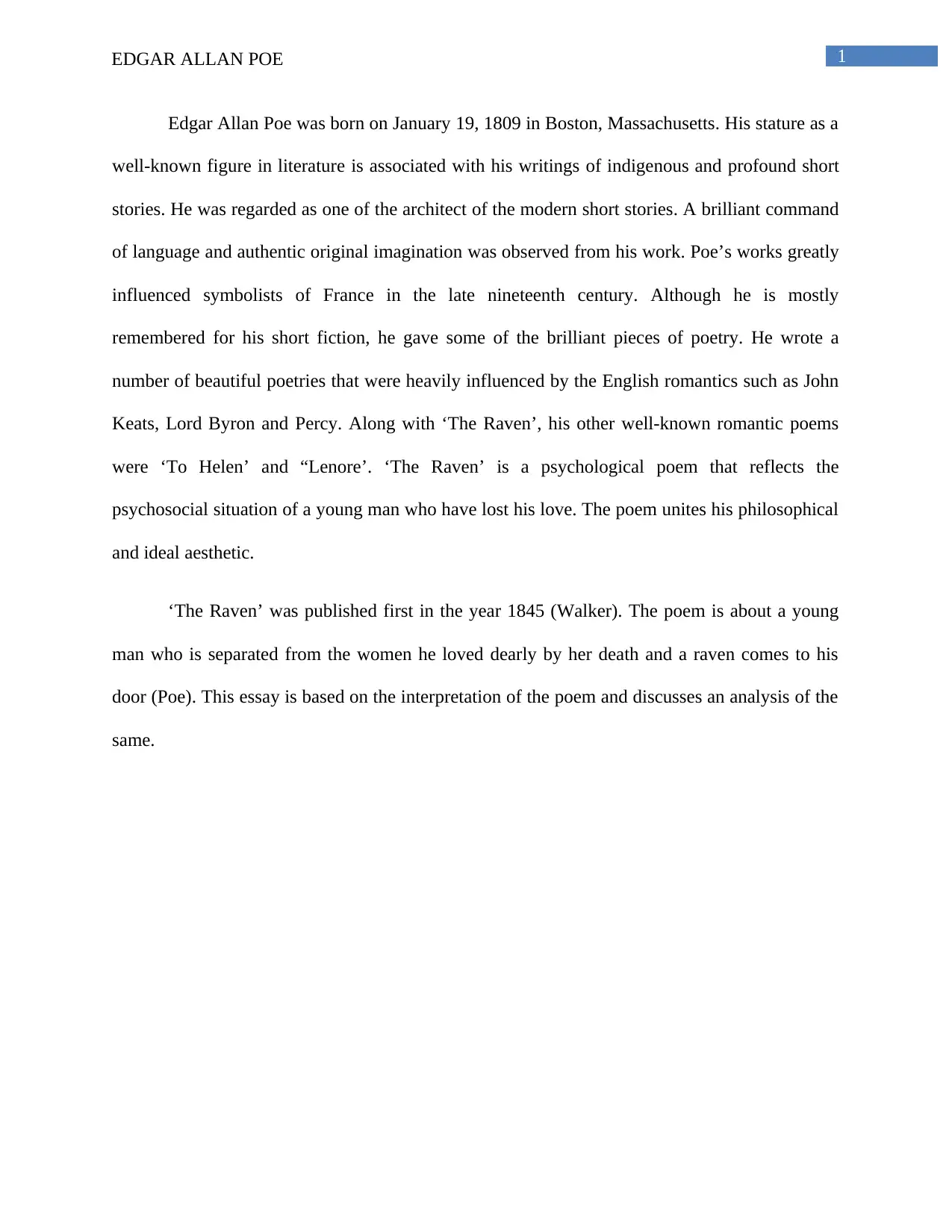
1EDGAR ALLAN POE
Edgar Allan Poe was born on January 19, 1809 in Boston, Massachusetts. His stature as a
well-known figure in literature is associated with his writings of indigenous and profound short
stories. He was regarded as one of the architect of the modern short stories. A brilliant command
of language and authentic original imagination was observed from his work. Poe’s works greatly
influenced symbolists of France in the late nineteenth century. Although he is mostly
remembered for his short fiction, he gave some of the brilliant pieces of poetry. He wrote a
number of beautiful poetries that were heavily influenced by the English romantics such as John
Keats, Lord Byron and Percy. Along with ‘The Raven’, his other well-known romantic poems
were ‘To Helen’ and “Lenore’. ‘The Raven’ is a psychological poem that reflects the
psychosocial situation of a young man who have lost his love. The poem unites his philosophical
and ideal aesthetic.
‘The Raven’ was published first in the year 1845 (Walker). The poem is about a young
man who is separated from the women he loved dearly by her death and a raven comes to his
door (Poe). This essay is based on the interpretation of the poem and discusses an analysis of the
same.
Edgar Allan Poe was born on January 19, 1809 in Boston, Massachusetts. His stature as a
well-known figure in literature is associated with his writings of indigenous and profound short
stories. He was regarded as one of the architect of the modern short stories. A brilliant command
of language and authentic original imagination was observed from his work. Poe’s works greatly
influenced symbolists of France in the late nineteenth century. Although he is mostly
remembered for his short fiction, he gave some of the brilliant pieces of poetry. He wrote a
number of beautiful poetries that were heavily influenced by the English romantics such as John
Keats, Lord Byron and Percy. Along with ‘The Raven’, his other well-known romantic poems
were ‘To Helen’ and “Lenore’. ‘The Raven’ is a psychological poem that reflects the
psychosocial situation of a young man who have lost his love. The poem unites his philosophical
and ideal aesthetic.
‘The Raven’ was published first in the year 1845 (Walker). The poem is about a young
man who is separated from the women he loved dearly by her death and a raven comes to his
door (Poe). This essay is based on the interpretation of the poem and discusses an analysis of the
same.
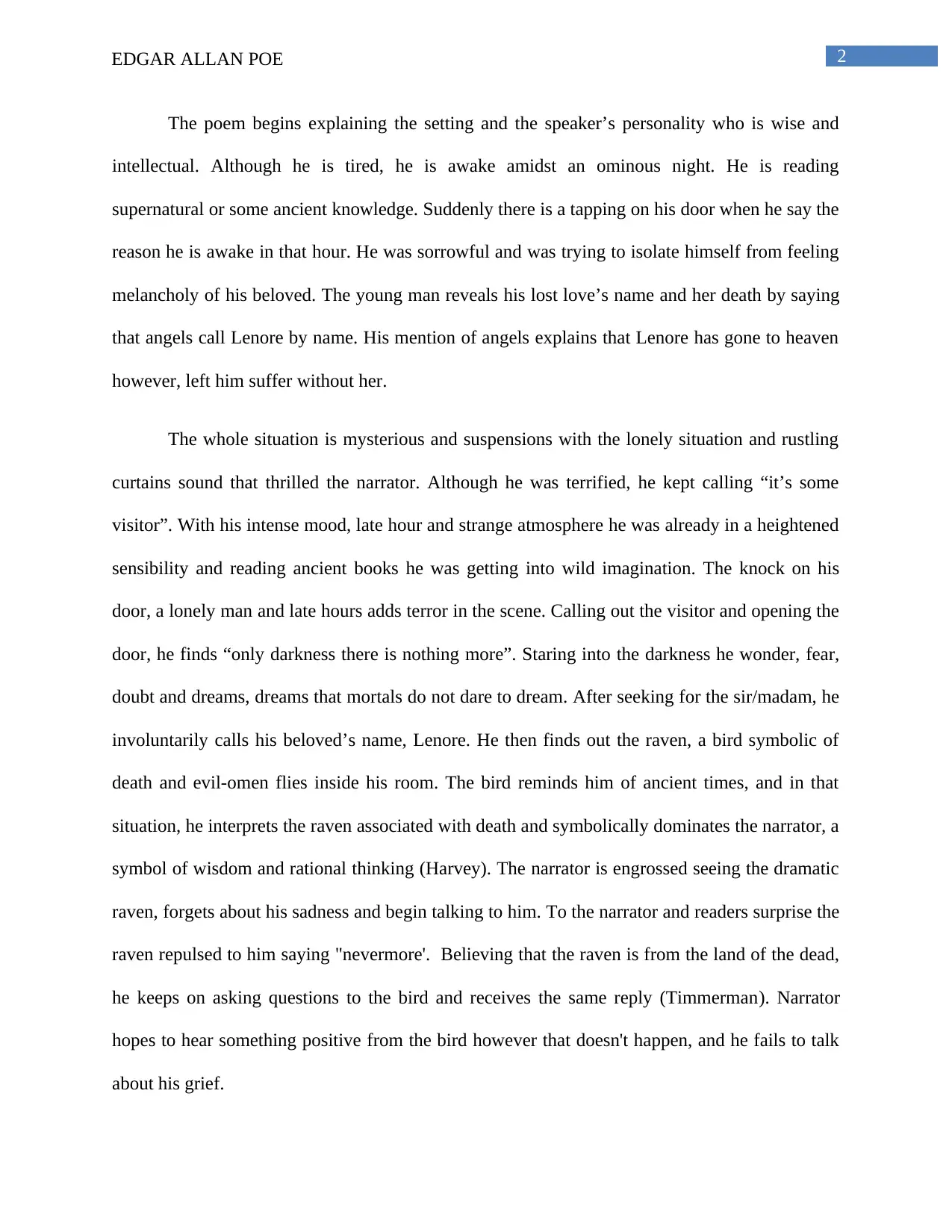
2EDGAR ALLAN POE
The poem begins explaining the setting and the speaker’s personality who is wise and
intellectual. Although he is tired, he is awake amidst an ominous night. He is reading
supernatural or some ancient knowledge. Suddenly there is a tapping on his door when he say the
reason he is awake in that hour. He was sorrowful and was trying to isolate himself from feeling
melancholy of his beloved. The young man reveals his lost love’s name and her death by saying
that angels call Lenore by name. His mention of angels explains that Lenore has gone to heaven
however, left him suffer without her.
The whole situation is mysterious and suspensions with the lonely situation and rustling
curtains sound that thrilled the narrator. Although he was terrified, he kept calling “it’s some
visitor”. With his intense mood, late hour and strange atmosphere he was already in a heightened
sensibility and reading ancient books he was getting into wild imagination. The knock on his
door, a lonely man and late hours adds terror in the scene. Calling out the visitor and opening the
door, he finds “only darkness there is nothing more”. Staring into the darkness he wonder, fear,
doubt and dreams, dreams that mortals do not dare to dream. After seeking for the sir/madam, he
involuntarily calls his beloved’s name, Lenore. He then finds out the raven, a bird symbolic of
death and evil-omen flies inside his room. The bird reminds him of ancient times, and in that
situation, he interprets the raven associated with death and symbolically dominates the narrator, a
symbol of wisdom and rational thinking (Harvey). The narrator is engrossed seeing the dramatic
raven, forgets about his sadness and begin talking to him. To the narrator and readers surprise the
raven repulsed to him saying "nevermore'. Believing that the raven is from the land of the dead,
he keeps on asking questions to the bird and receives the same reply (Timmerman). Narrator
hopes to hear something positive from the bird however that doesn't happen, and he fails to talk
about his grief.
The poem begins explaining the setting and the speaker’s personality who is wise and
intellectual. Although he is tired, he is awake amidst an ominous night. He is reading
supernatural or some ancient knowledge. Suddenly there is a tapping on his door when he say the
reason he is awake in that hour. He was sorrowful and was trying to isolate himself from feeling
melancholy of his beloved. The young man reveals his lost love’s name and her death by saying
that angels call Lenore by name. His mention of angels explains that Lenore has gone to heaven
however, left him suffer without her.
The whole situation is mysterious and suspensions with the lonely situation and rustling
curtains sound that thrilled the narrator. Although he was terrified, he kept calling “it’s some
visitor”. With his intense mood, late hour and strange atmosphere he was already in a heightened
sensibility and reading ancient books he was getting into wild imagination. The knock on his
door, a lonely man and late hours adds terror in the scene. Calling out the visitor and opening the
door, he finds “only darkness there is nothing more”. Staring into the darkness he wonder, fear,
doubt and dreams, dreams that mortals do not dare to dream. After seeking for the sir/madam, he
involuntarily calls his beloved’s name, Lenore. He then finds out the raven, a bird symbolic of
death and evil-omen flies inside his room. The bird reminds him of ancient times, and in that
situation, he interprets the raven associated with death and symbolically dominates the narrator, a
symbol of wisdom and rational thinking (Harvey). The narrator is engrossed seeing the dramatic
raven, forgets about his sadness and begin talking to him. To the narrator and readers surprise the
raven repulsed to him saying "nevermore'. Believing that the raven is from the land of the dead,
he keeps on asking questions to the bird and receives the same reply (Timmerman). Narrator
hopes to hear something positive from the bird however that doesn't happen, and he fails to talk
about his grief.
⊘ This is a preview!⊘
Do you want full access?
Subscribe today to unlock all pages.

Trusted by 1+ million students worldwide
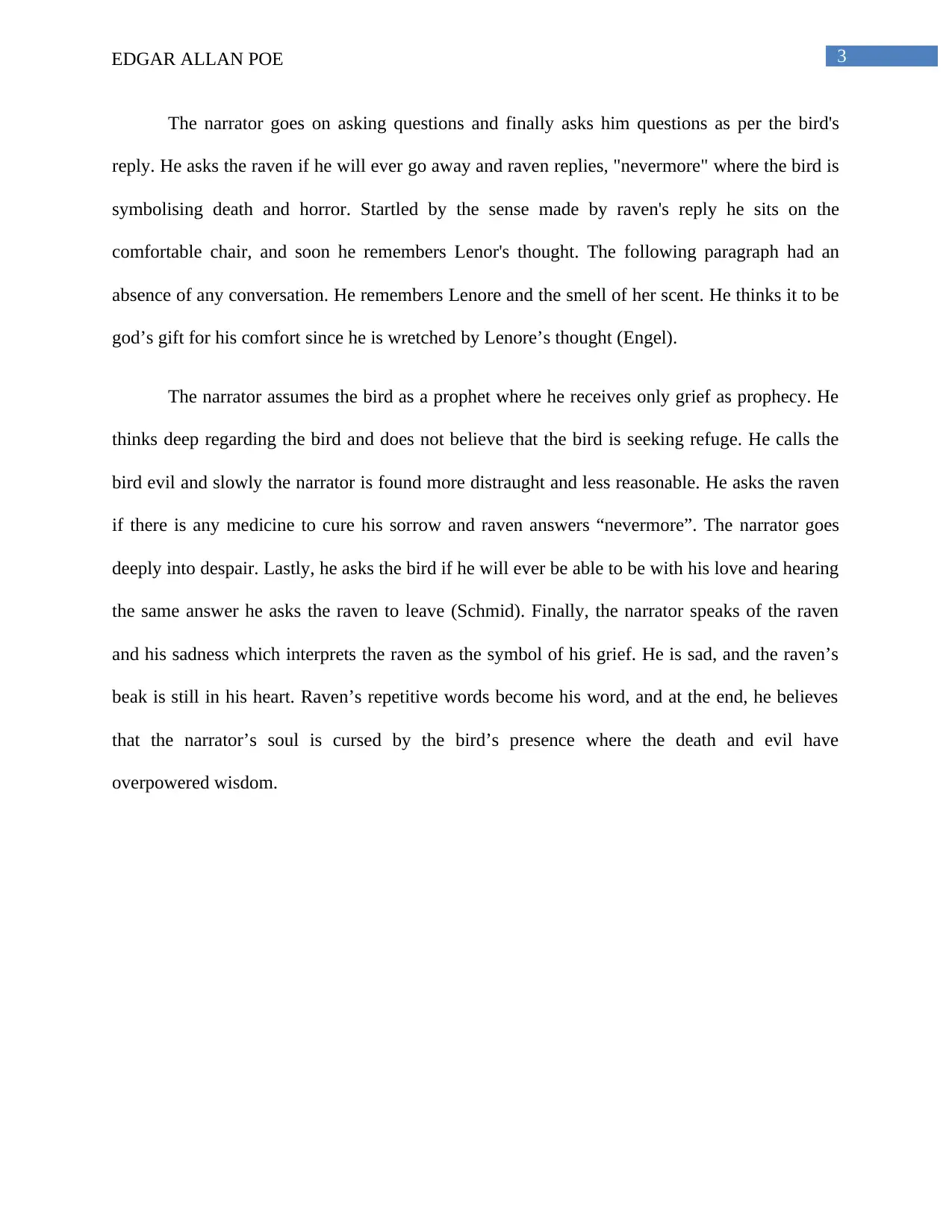
3EDGAR ALLAN POE
The narrator goes on asking questions and finally asks him questions as per the bird's
reply. He asks the raven if he will ever go away and raven replies, "nevermore" where the bird is
symbolising death and horror. Startled by the sense made by raven's reply he sits on the
comfortable chair, and soon he remembers Lenor's thought. The following paragraph had an
absence of any conversation. He remembers Lenore and the smell of her scent. He thinks it to be
god’s gift for his comfort since he is wretched by Lenore’s thought (Engel).
The narrator assumes the bird as a prophet where he receives only grief as prophecy. He
thinks deep regarding the bird and does not believe that the bird is seeking refuge. He calls the
bird evil and slowly the narrator is found more distraught and less reasonable. He asks the raven
if there is any medicine to cure his sorrow and raven answers “nevermore”. The narrator goes
deeply into despair. Lastly, he asks the bird if he will ever be able to be with his love and hearing
the same answer he asks the raven to leave (Schmid). Finally, the narrator speaks of the raven
and his sadness which interprets the raven as the symbol of his grief. He is sad, and the raven’s
beak is still in his heart. Raven’s repetitive words become his word, and at the end, he believes
that the narrator’s soul is cursed by the bird’s presence where the death and evil have
overpowered wisdom.
The narrator goes on asking questions and finally asks him questions as per the bird's
reply. He asks the raven if he will ever go away and raven replies, "nevermore" where the bird is
symbolising death and horror. Startled by the sense made by raven's reply he sits on the
comfortable chair, and soon he remembers Lenor's thought. The following paragraph had an
absence of any conversation. He remembers Lenore and the smell of her scent. He thinks it to be
god’s gift for his comfort since he is wretched by Lenore’s thought (Engel).
The narrator assumes the bird as a prophet where he receives only grief as prophecy. He
thinks deep regarding the bird and does not believe that the bird is seeking refuge. He calls the
bird evil and slowly the narrator is found more distraught and less reasonable. He asks the raven
if there is any medicine to cure his sorrow and raven answers “nevermore”. The narrator goes
deeply into despair. Lastly, he asks the bird if he will ever be able to be with his love and hearing
the same answer he asks the raven to leave (Schmid). Finally, the narrator speaks of the raven
and his sadness which interprets the raven as the symbol of his grief. He is sad, and the raven’s
beak is still in his heart. Raven’s repetitive words become his word, and at the end, he believes
that the narrator’s soul is cursed by the bird’s presence where the death and evil have
overpowered wisdom.
Paraphrase This Document
Need a fresh take? Get an instant paraphrase of this document with our AI Paraphraser
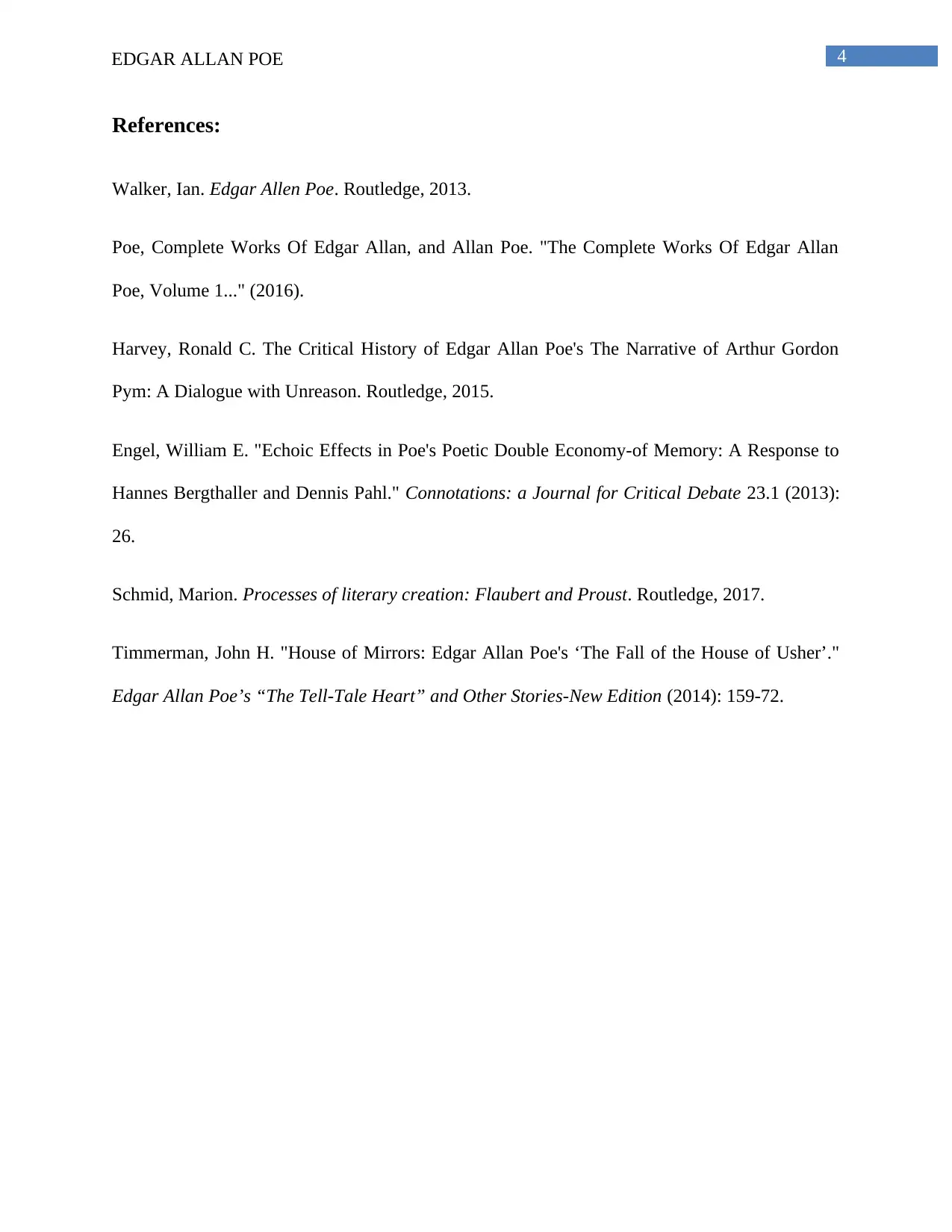
4EDGAR ALLAN POE
References:
Walker, Ian. Edgar Allen Poe. Routledge, 2013.
Poe, Complete Works Of Edgar Allan, and Allan Poe. "The Complete Works Of Edgar Allan
Poe, Volume 1..." (2016).
Harvey, Ronald C. The Critical History of Edgar Allan Poe's The Narrative of Arthur Gordon
Pym: A Dialogue with Unreason. Routledge, 2015.
Engel, William E. "Echoic Effects in Poe's Poetic Double Economy-of Memory: A Response to
Hannes Bergthaller and Dennis Pahl." Connotations: a Journal for Critical Debate 23.1 (2013):
26.
Schmid, Marion. Processes of literary creation: Flaubert and Proust. Routledge, 2017.
Timmerman, John H. "House of Mirrors: Edgar Allan Poe's ‘The Fall of the House of Usher’."
Edgar Allan Poe’s “The Tell-Tale Heart” and Other Stories-New Edition (2014): 159-72.
References:
Walker, Ian. Edgar Allen Poe. Routledge, 2013.
Poe, Complete Works Of Edgar Allan, and Allan Poe. "The Complete Works Of Edgar Allan
Poe, Volume 1..." (2016).
Harvey, Ronald C. The Critical History of Edgar Allan Poe's The Narrative of Arthur Gordon
Pym: A Dialogue with Unreason. Routledge, 2015.
Engel, William E. "Echoic Effects in Poe's Poetic Double Economy-of Memory: A Response to
Hannes Bergthaller and Dennis Pahl." Connotations: a Journal for Critical Debate 23.1 (2013):
26.
Schmid, Marion. Processes of literary creation: Flaubert and Proust. Routledge, 2017.
Timmerman, John H. "House of Mirrors: Edgar Allan Poe's ‘The Fall of the House of Usher’."
Edgar Allan Poe’s “The Tell-Tale Heart” and Other Stories-New Edition (2014): 159-72.
1 out of 5
Related Documents
Your All-in-One AI-Powered Toolkit for Academic Success.
+13062052269
info@desklib.com
Available 24*7 on WhatsApp / Email
![[object Object]](/_next/static/media/star-bottom.7253800d.svg)
Unlock your academic potential
Copyright © 2020–2025 A2Z Services. All Rights Reserved. Developed and managed by ZUCOL.



